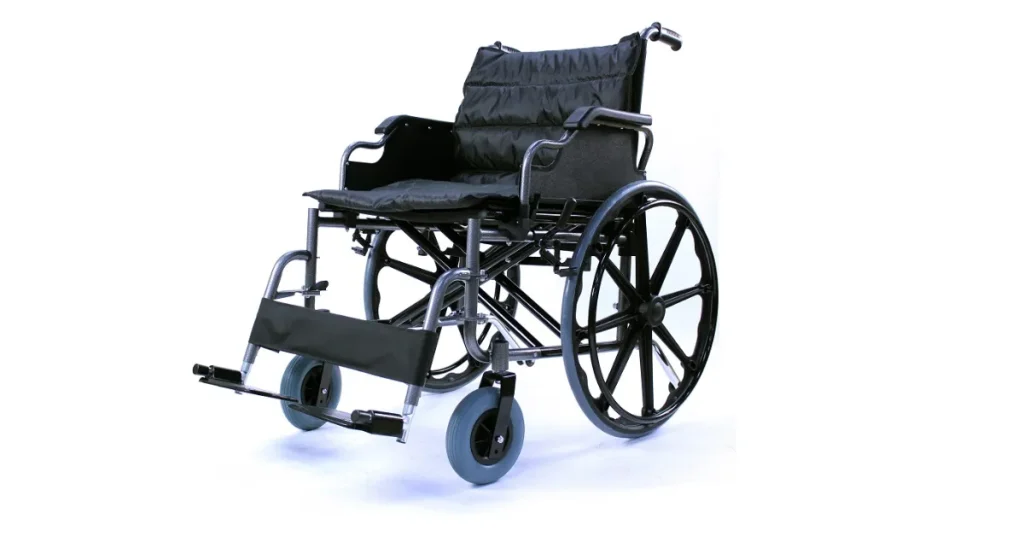A bariatric wheelchair typically ranges from 22 to 30 inches in seat width. These wheelchairs are designed to accommodate users up to 700 pounds.
Bariatric wheelchairs cater to individuals who require additional space and weight capacity.
They provide comfort and mobility solutions for heavier users, ensuring safe and easy maneuverability. Traditional wheelchairs usually have a seat width of 16 to 18 inches, suitable for average built users.
In contrast, bariatric models are specifically engineered with sturdier frames, reinforced hinges, and wider seats to meet the needs of larger individuals. These chairs often come equipped with adjustable components like footrests and armrests to enhance support and customization.
Opting for a bariatric wheelchair means investing in a dependable, secure, and comfortable mobility aid that can greatly improve the quality of life for its users. It’s essential for buyers to consider the specific dimensions and the weight limit of the chair to ensure it meets the user’s needs.

Introduction To Bariatric Wheelchairs
Finding the right bariatric wheelchair is crucial for comfort and mobility. Bariatric wheelchairs support larger individuals. They help in moving around safely. Their design is suitable for heavier weights. Wide seats and strong frames are key features.
The Importance Of Proper Sizing
Choosing the right size wheelchair is essential. Proper sizing ensures comfort and prevents injuries. A well-fitted wheelchair improves posture. It also supports daily activities.
- Seat width and depth match the user’s size.
- Durable materials hold up against more weight.
- Stability comes with the right wheel and frame size.
Understanding Bariatric Needs
Bariatric individuals have unique needs. Wheelchairs must support a wider frame and heavier weight. Comfort and ease of use are important. Strong materials and construction matter.
| Feature | Description |
| Seat Width | Wider than standard wheelchairs, ensuring a comfortable fit. |
| Weight Capacity | Higher to accommodate more weight without compromising safety. |
| Frame Construction | Reinforced with durable materials for longevity and stability. |
It’s important to measure the user before choosing a bariatric wheelchair. Correct fitting promotes independence and well-being.
Measuring The User For A Bariatric Wheelchair

Finding the perfect fit for a bariatric wheelchair involves precise measurements. These critical dimensions ensure comfort and support. Catering to the specific needs of users with larger body sizes, the correct size of a bariatric wheelchair is essential for mobility and independence.
Key Body Measurements
Accurate body measurements are the first step to finding the right bariatric wheelchair. The vital measurements include:
- Seat width: Measure the user’s widest point when sitting, usually the hips or thighs. Add a few inches for clearance.
- Seat depth: Measure from the back of the hip to the back of the knee when seated. Ensure a gap of 1 to 2 inches from the seat’s edge.
- Back height: From the seat to the top of the shoulders, to determine the back support needed.
- Armrest height: Measure from the seat to the elbow with the arm resting at a 90-degree angle.
- Seat-to-floor height: Measurement from the user’s heel to the back of the knee sets the correct footrest height.
Factors Influencing Wheelchair Size
Several elements impact bariatric wheelchair size selection:
| Factor | Consideration |
| User size and weight | Determines wheelchair frame strength and seat capacity |
| Mobility needs | Influences width for maneuvering in tight spaces |
| Daily activities | Considers aspects such as transportability and adjustable components |
| Personal comfort | Identifies the need for additional cushioning or support |
Always consult with a healthcare professional to ensure a proper fit. They provide valuable guidance to accommodate your unique needs.
Standard Widths Of Bariatric Wheelchairs
When choosing a bariatric wheelchair, width is a key factor for comfort and functionality. These wheelchairs come in various sizes to accommodate different users. Let’s explore the common measurements and options for customization.
Common Bariatric Wheelchair Dimensions
Bariatric wheelchairs are built to support larger weights. They often have reinforced frames and wider seats. The typical seat width ranges from 20 inches to 30 inches. Here is a breakdown of standard sizes:
| Seat Width | User Weight Capacity |
| 20 inches | Up to 300 lbs |
| 22 inches | 300 – 400 lbs |
| 24 inches | 400 – 500 lbs |
| 26 inches | 500 – 600 lbs |
| 28 inches | 600 – 700 lbs |
| 30 inches | Above 700 lbs |
Customization Of Sizes
Customizing a wheelchair offers a perfect fit. Users can select seat width, depth, and height. Other adjustable features include the backrest and armrest. Custom fittings ensure maximum security and ease. Below is a list of customizable features:
- Seat width – tailored to body size
- Seat depth – adjusted for leg length
- Seat height – set for easy transfer
- Backrest – contoured for spine support
- Armrests – positioned for arm relief
Consult professionals to get the right fit. They measure and suggest adjustments for a personal wheelchair. This service boosts comfort and mobility.
Comfort And Mobility Considerations
Finding the perfect bariatric wheelchair involves more than measuring width. Comfort and mobility are key to daily life.
A wheelchair must fit like a glove, supporting every move with ease. We’re diving into seat depth and height, plus armrest and footrest adjustability, to pinpoint optimal comfort.
Seat Depth And Height
Ideal seat depth and height matter for support and circulation.
- Seat depth prevents sliding
- Optimal height eases transfers
To measure seat depth, note the distance from one’s back to the knees.
For height, ensure the user’s feet rest flat on the ground.
Armrest And Footrest Adjustability
Adjustable armrests and footrests cater to personal comfort.
User comfort and daily tasks gain from tailored settings.
| Feature | Benefit |
| Armrest Height | Reduces shoulder strain |
| Footrest Position | Prevents pressure sores |
Adjusting these parts should be effortless and secure.
Ensure devices lock in place, avoiding slips.
Additional Features For Enhanced Support
When choosing a bariatric wheelchair, width is just the start. Extra features provide the support and comfort needed for daily use.
These wheelchairs come with robust design touches. They ensure both safety and ease for heavier users. Let’s explore some key features that enhance these vital mobility aids.
Reinforced Frames And Materials
Bariatric wheelchairs must handle more weight than standard chairs. They have reinforced frames for added strength. The use of heavy-duty materials is common.
Manufacturers often opt for high-tensile steel or reinforced aluminum. These materials keep the wheelchair both sturdy and somewhat lightweight.
- Durable metals resist bending and warping under weight.
- Welds are extra secure to prevent breakage.
- Wider berth between frame sides gives stability
Specialized Cushioning And Support
Comfort is crucial in a bariatric wheelchair. Thick, specialized cushioning helps distribute weight evenly. This prevents pressure sores. Many chairs come with memory foam or gel cushions. These adapt to the user’s body for the perfect fit. Additional support features include:
| Feature | Description |
| Adjustable Armrests | Change in height for personal comfort |
| Lumbar Support | Extra padding for lower back support |
| Leg Rests | Elevates legs to reduce swelling |
Navigating Spaces With A Bariatric Wheelchair

Width matters when it comes to wheelchairs and accessibility. Bariatric wheelchairs cater to those who need extra width for comfort and safety.
Bariatric models typically range from 22 to 30 inches in seat width, much wider than standard wheelchairs. The right size enhances mobility, particularly in various spaces. Let’s delve into the specifics of navigating areas with a bariatric wheelchair.
Home And Office Modifications
- Doorways should be a minimum of 32 inches wide.
- Clear paths free of obstructions ensure smooth passage.
- Ramps and lifts may replace stairs for accessibility.
- Sturdy grab bars aid in safe transfers.
- Ample room around furniture allows better maneuverability.
Homes and offices might need adjustments for wheelchair access. Here are some key considerations:
| Area | Modification | Minimum Width |
| Doors | Widen to allow wheelchair | 32 inches |
| Hallways | Remove clutter, widen if necessary | 36 inches |
| Bathrooms | Install safety bars, accessible fixtures | 34 inches |
Attention to these details enables seamless movement around homes and workplaces.
Transportation And Public Accessibility
Getting around town should not be a hassle for bariatric wheelchair users. Public spaces and transportation services are becoming more considerate of wider wheelchairs.
In transportation:
- Accessible vehicles offer ramps or lifts and secure tie-downs.
- Buses and trains allocate space for wider wheelchairs.
In public spaces:
- Elevators must accommodate the extra width of bariatric wheelchairs.
- Accessible seating areas ensure comfort during events.
- Aisles and walkways must be wide enough for easy navigation.
These inclusion efforts make travel and enjoyment of public amenities possible for everyone.
FAQs About How Wide Is A Bariatric Wheelchair
What Width Is A Bariatric Wheelchair?
Bariatric wheelchairs typically range from 20 to 30 inches in seat width to accommodate larger users.
How Wide Is A Wheelchair For An Obese Person?
A wheelchair for an obese person typically ranges from 26 to 30 inches wide. This extra width accommodates higher weight capacities and provides added comfort.
What Is The Difference Between A Standard And Bariatric Wheelchair?
A standard wheelchair typically supports up to 250-300 pounds, while a bariatric wheelchair is designed for users over 300 pounds, offering wider seats and reinforced frames for increased weight capacity and comfort.
What Are The Widths Of Wheelchairs?
Wheelchair widths typically range from 21 to 30 inches, with standard adult wheelchairs averaging 24 to 27 inches wide. These measurements reflect overall width, influenced by seat size and wheel spacing.
Conclusion
Understanding the width of a bariatric wheelchair is crucial for optimal comfort and accessibility.
With options ranging from 22 to 30 inches, finding the right fit depends on individual needs and the environment. Remember, the perfect wheelchair enhances mobility and maintains user dignity.
Choose wisely for a better quality of life.
Resources:
1. https://www.medicare.gov/coverage/wheelchairs-scooters
